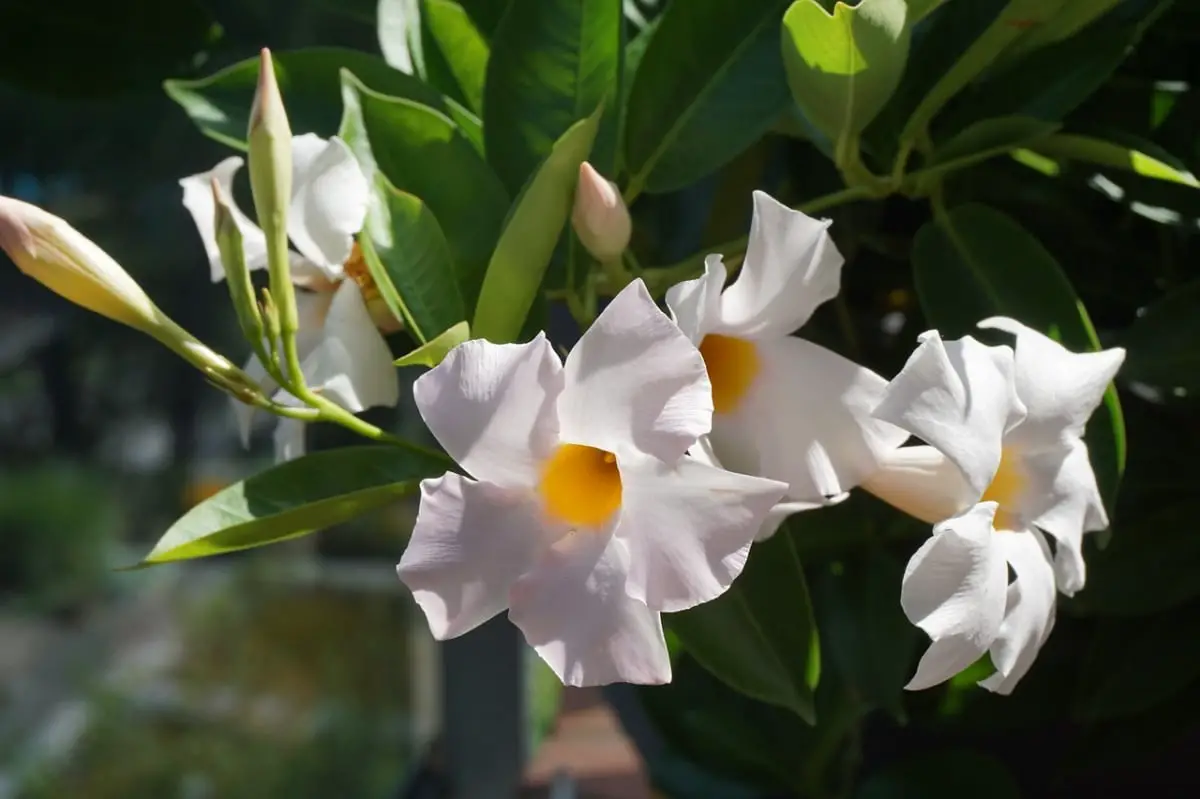
White dipladenia is a plant that can be kept indoors, but is also sometimes grown outdoorsin small trellises or gardens. Its growth rate is fast during the warm months, although it is slower and even null in winter. Due to their origin and evolution, their genes are programmed to resist heat, but without becoming suffocating; on the contrary, low temperatures destroy the cells, so the plant weakens and can even die, especially if frost occurs.
For this reason, one way to keep it evergreen and in good health in temperate regions is to keep it indoors, at least during the cold months of the year. Let’s know more about her.
What is the meaning of white dipladenia?

Humans have a great tendency to give everything a name, and to associate emotions with moments or colors, although sometimes these meanings are a bit contradictory. For example, black is the symbol of death, loss, and the night, but it is also the color of elegance, power, and prestige.
Therefore, as a curiosity it is good to know what the white color of the dipladenia, since it can be useful if you want to give it to someone for a special reason, or decorate the house to breathe a calm atmosphere. So what does it mean? Okay, we must start from the basis that white has always been associated with purity, cleanliness, calm, and innocence. It is the one used to paint the walls of health centers, as well as homes, hotels, etc. But what about dipladenia that have white flowers?
These also have a very beautiful meaning. Without forgetting what we have already said about white, its flowers are associated with overcoming. For this reason, they are a good gift for those who are going through a difficult time. In addition, white is a very beautiful color, and even more so if it is the one that the flowers of a mandevilla have, so it is a good excuse to smile.
What uses does it have?

Image – Flickr / Stefano
Our protagonist is a climber that used as an ornamental plant. It has no further use, as its sap is toxic: if it comes into contact with a wound, it will cause irritation, itching and redness; even on healthy skin, if it is sensitive, it can also cause these symptoms to a greater or lesser extent, depending on the degree of sensitivity and how your body reacts to it.
To avoid problems, it is important to put on gloves every time you are going to manipulatebut not just any gloves: they must be rubber, waterproof, like the ones used to wash dishes, for example. Also, every time you have to prune it, something that can be done if the stems are growing too much in late winter or early spring, you have to use clean scissors, previously disinfected with alcohol from the pharmacy.
Now, where can it be grown? Well for example:
- In pots or in the ground to cover trellises, arches, or columns.
- On the balcony or on a high table as a hanging plant.
- In the garden grown on trellises.
How to care for a white dipladenia?

Related article:
Dipladenia: care at home and abroad
The care that you have to provide to a white dipladenia is the same that any other dipladenia needs. To begin with, you must bear in mind that we are talking about plants that they need light, heat and high environmental humidityso in winter temperatures drop below 5ºC you will have to protect it either at home, or with an anti-frost cloth, although the latter would only work if there are frosts but they are very weak (up to -2ºC) and occasional.
Another thing to do is to water. They do not resist drought, so they must be supplied with water every time the land dries up. But beware, you do not have to keep the soil permanently moist, because if there is something that they fear more than drought, it is excess water, which rots the roots. In fact, so that problems do not arise, it is worth inserting a thin wooden stick to the bottom and see if it comes out clean (in which case we would water it) or if, on the contrary, a lot of soil has adhered to it. But in general, they should be watered every 3 or 4 days in summer, and every 5-7 days the rest of the year.

Finally, it is also highly recommended pay them throughout the year, even in winter. It is interesting that they grow as much as possible when the weather is warm, and thus arrive strong in autumn-winter, but also, with a winter fertilizer we will make it better cope with the cold. In the first case, we will use quick-efficiency manures or fertilizers, such as guano or fertilizer for flowering plants; in the second, we will opt for slow-release products, such as earthworm humus.
So I hope your white dipladenia grows up healthy and happy.

